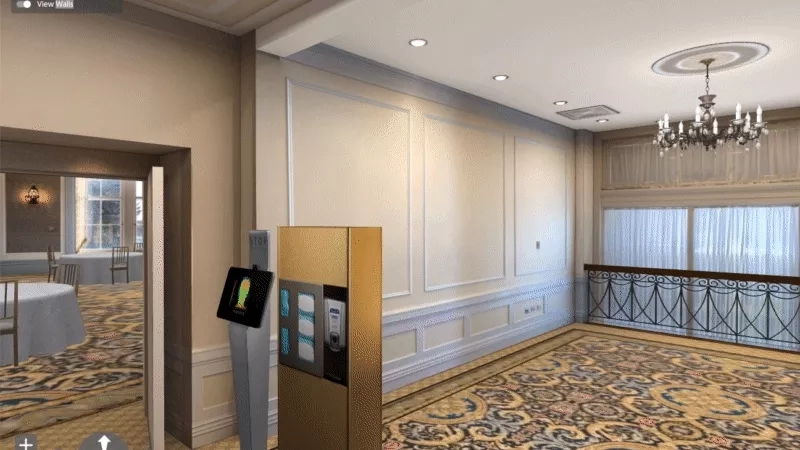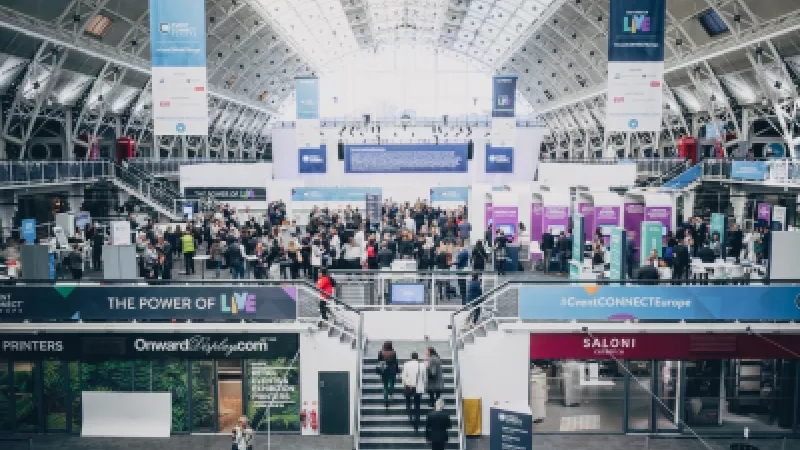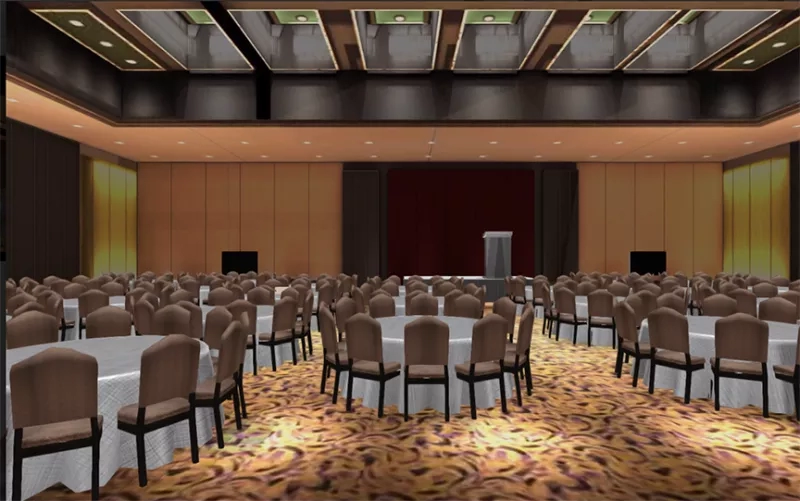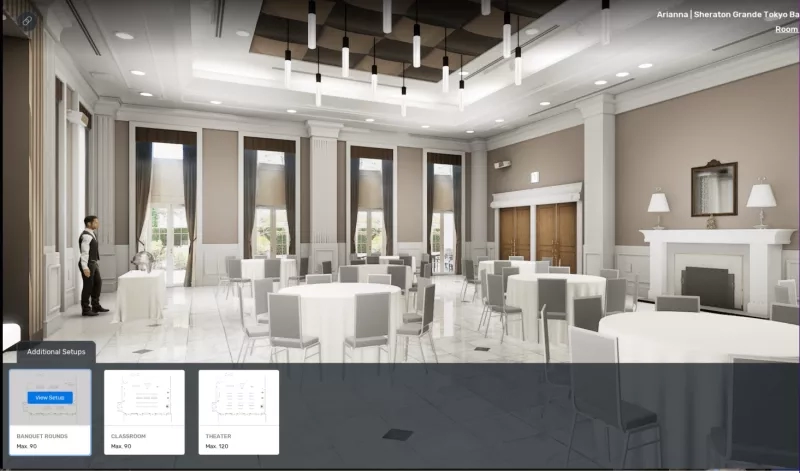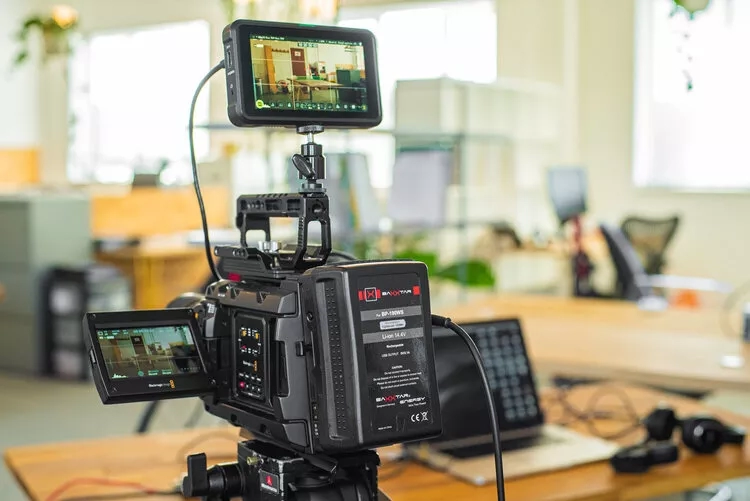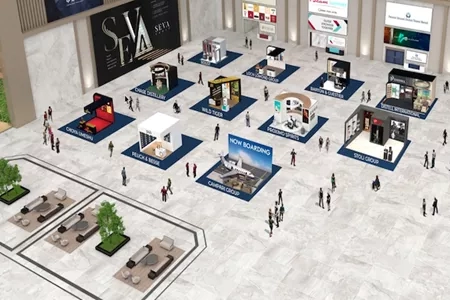The COVID-19 pandemic has accelerated the virtual tour industry's growth, revolutionizing how businesses operate. With its versatility and adaptability, virtual tours are an indispensable asset for event venues, offering numerous benefits such as increased bookings and an immersive customer experience.
In this blog, we'll explore the key advantages of virtual tours and provide essential tips for creating a successful virtual tour experience. From harnessing the power of technology to understanding your target audience, unlock the secrets to staying competitive in your industry.
What Is a Virtual Tour?
A virtual tour is a digital representation, sometimes using 3D rendering techniques, that recreates the experience of exploring a physical location. It often uses interactive features called "hotspots" that let you move from one area to another.
Virtual tours go by many names – digital tour, panoramic tour, 360 tour, 360-degree tour, 3D tour, immersive experience, interactive tour, online tour, remote tour, and virtual reality – but they all aim to simulate the experience of physically walking through and interacting with a space.
Types of Virtual Tours
Virtual tours are a fantastic way to experience a location without being there, and they come in different types with unique features. Let's explore these main types of virtual tours:
360 Virtual Tour
This is one of the most accessible and common types of virtual tours. It provides a 360-degree view of a space, allowing users to look around from any angle. These tours are typically created by merging multiple camera shots or using a 360-degree camera to capture the entire environment.
They are easy to develop and can be embedded in websites and apps, making them widely accessible. 360 virtual tours benefit real estate listings, tourism destinations, and event venues by giving prospective clients or customers a virtual walk-through experience.
3D Virtual Tour
As the name suggests, this type of tour offers a three-dimensional experience. The entire environment of the tour is created in 3D, allowing users to explore a location in a more immersive and realistic way.
3D virtual tours are often more detailed and interactive than 360-degree tours and can be accessed through web applications or mobile, desktop, and other platforms. These types of tours can even be used to populate fictional or long-gone locations, making them applicable to various industries and use cases.
Virtual Reality (VR) Tour
Taking virtual tours to the next level, VR tours provide an unprecedented level of immersion and realism. With a headset and appropriate software, users can feel like they are standing in the location and taking in the surroundings. VR tours are created in 3D, allowing users to look around by moving their heads and interacting with the environment using controllers with the headset.
According to a recent study, the virtual reality market is projected to reach $165.91 billion by 2030, indicating the growing popularity of this technology. This type of tour is ideal for destinations like museums, archaeological sites, and venues where offering an immersive experience is valuable.
Where Are Virtual Tours Used?
Virtual tours have become a powerful tool adopted by various industries to enhance their marketing efforts, provide immersive experiences, and improve customer engagement. Here are some industries that use virtual tours:
Events and Conferences
Virtual tours are a key tool in venue sourcing for event organizers. They provide a realistic, immersive view of a venue's layout, amenities, and configurations, aiding in informed decision-making. Unlike traditional 2D plans or static images, the latest virtual tours allow a three-dimensional visualization of the space, enhancing understanding of traffic flow and seating arrangements to ensure venue suitability.
For hotels and hospitality venues, virtual tours are vital for venue marketing and showcasing facilities and ambiance to potential clients. They help attract bookings by offering a virtual experience of the property, which is particularly beneficial for venues in scenic locations or with unique features.
Brick and Mortar Businesses
Many physical businesses, such as retail stores, restaurants, hotels, and museums, use virtual tours to provide potential customers with an interactive and immersive experience of their premises. This allows customers to "visit" these places virtually even before making an actual trip.
Real Estate
Real estate agents often create virtual tours for properties to offer potential buyers a more comprehensive and convenient way to view listings. Virtual tours can include 360-degree views of different rooms, providing a better understanding of the space and layout than static images alone.
Real estate developers also use virtual tours to showcase off-plan or unfinished properties to potential buyers. This lets buyers visualize the finished project and make more informed purchasing decisions.
Tourism and Travel
The tourism industry widely uses virtual tours to promote destinations, hotels, and attractions. Virtual tours enable potential travelers to get a glimpse of a location's beauty, culture, and amenities before planning their actual trip.
Art and Culture
Art galleries, museums, and historical sites often create virtual tours to provide access to their collections and exhibitions to a broader audience. Virtual tours can include interactive features, such as zooming capabilities and audio guides, to offer an immersive and informative experience.
Automotive Industry
Automotive companies use virtual tours to showcase the interior features and designs of their vehicles. It gives customers a more interactive and engaging experience than traditional static images or videos.
What Are the Main Advantages of Virtual Tours?
Virtual tours offer significant advantages for businesses looking to attract clients, including:
1. Expanding Customer Reach and Access
With virtual tours, businesses can market spaces and offerings to a nearly unlimited global audience online – far broader than feasible via in-person tours alone. The expanded access and visibility also aid Search Engine Optimization, helping drive more organic traffic.
2. Empowering Informed Decision Making
By navigating location renderings, clients can evaluate layouts, capacity, amenities, etc., in detail before committing to customizing spaces in their mind's eye. It empowers selection based on precise needs and preferences versus relying solely on imagination.
3. Enhancing Visualization
Virtual tours allow clients to tour sample event setups and decor rather than just empty space. This visual evidence lends confidence by demonstrating venues successfully hosting relevant events with suitable arrangements and amenities.
4. Improving Sales Efficiency
Exploring options virtually expedites decision-making by enabling rapid, self-guided tours of shortlisted spaces instead of lengthy in-person visits. This pre-qualification yields more qualified booking leads.
5. Increasing Bookings
With more informed clients focused on preferred options, virtual tours ultimately convert interest into more booked events. They set accurate expectations while expanding visibility to more potential booking leads.
How to Create a Virtual Tour
Creating a virtual tour involves capturing 360-degree images of a space and stitching them together using appropriate software. This can be achieved by following a few simple steps:
Select Your Equipment
You don’t need to invest in an expensive setup to start creating virtual tours. It’s even possible to buy an affordable fisheye lens adapter for your phone to create the wide-resolution photos you need. However, if you’re looking for the best quality, you may want to upgrade to a full DSLR camera (for a hefty price, of course).
After you pick your camera, you’ll also want to ensure you have a tripod that can rotate on an axis so you can capture all aspects of a room in a steady, controlled way.
Choose Your Virtual Tour Software
After you find a camera that can capture your images, you’ll want to decide what type of virtual tour software you’ll use to stitch them all together. You have several options with benefits and trade-offs for various event design needs and budgets.
Plan Out Your Photos
Before recording your footage, you must plan your walk-through and know where to place the camera in every room. Ideally, you’ll want to go to the center of the room to capture it in its entirety. However, in rooms that aren’t symmetrical, you may need to find a different location, so test it out.
Because the virtual tour mimics walking through the site, you must also plan your route. For example, you can’t start from the stage and then jump down to the lobby – the connection simply won’t make sense. Try to shoot your footage logically, and do not skip any important spaces. Use an event design software to plan the layout, if required.
Test Your Equipment and Lighting
When it’s finally photo day, test your camera, equipment, and angles for a final time. Make sure your tripod is level to prevent crooked or warped photos.
Next, go to each meeting room and see what the photos look like. Is the lighting too dark? Try the overhead light. Still too dark? You may want to have extra lighting on hand to illuminate the room.
Also, ensure you and the camera aren’t reflected in mirrors or windows. If you do notice a reflection, adjust your angle.
Take Your Photos and Upload Them to Your Software
Finally, the most important part – taking the photos! Follow your shoot checklist, and don’t be afraid to take multiple pictures in each room, just in case. After you have all your photos captured, it’s time to upload them to the software you’ve chosen.
Once your tour is created, add music, room descriptions, interactive links, and more. To create engaging and interactive 3D virtual tours, consider using 3D virtual tour software to create immersive experiences.
10 Ways to Maximize the Reach of Virtual Tours
The key to maximizing the reach of your virtual tour is to adopt a multifaceted and creative approach to marketing and promotion. Continuously seek new opportunities, adapt to changing trends, and engage with your audience to build momentum and sustain interest in your virtual tour experience.
Here are some tactics you can use to maximize the reach and impact of your virtual tours.
1. Optimize for Search Engines: Utilize relevant keywords, meta tags, and descriptions to make your virtual tour and its dedicated web page discoverable through search engines. This increases the chances of your target audience finding your tour organically while looking for related content.
2. Collaborate with Influencers and Industry Experts: Partner with influencers or industry experts with a substantial following or engagement in your target niche. Having them promote or endorse your virtual tour can expand its reach to a wider audience and boost credibility.
3. Host Virtual Tours for Influencers and Media: Invite influencers, media representatives, or other relevant individuals to experience your virtual tour first-hand. Providing exclusive access can encourage them to feature or share your tour with their audiences, which can be a powerful form of social proof and organic promotion.
4. Leverage Online Travel Agencies (OTAs) and Listing Platforms: List your virtual tour on online travel agencies (OTAs) or listing platforms specific to your industry. This allows individuals searching for virtual tour experiences to discover your tour directly, expanding your reach to a targeted audience.
5. Encourage User-Generated Content (UGC): Empower visitors of your virtual tour to create and share their experiences through user-generated content. This can include sharing photos or videos of their virtual tour experience on social media with branded hashtags, which helps generate organic word-of-mouth marketing and expands your reach.
6. Run Contests and Promotions: Launch contests or promotions around your virtual tour experience. Encourage participants to engage with your tour and share their experiences on social media, with the chance to win prizes or discounts. It creates a buzz around your tour and attracts a wider audience.
7. Utilize Paid Advertising: Consider investing in paid advertising on social media platforms or search engines to promote your virtual tour. Targeted ads can help reach a wider audience and drive more immediate traffic to your tour, especially when combined with compelling visuals and copy.
8. Create a Virtual Tour Trailer or Sneak Peek: Produce a short trailer or sneak peek video showcasing your virtual tour's highlights. Distribute this video across social media platforms to generate excitement and interest among potential visitors.
9. Cross-Promote with Other Local Businesses: Collaborate with local businesses or establishments related to your virtual tour theme. Cross-promote each other's content or offer joint discounts or packages to attract a combined audience and boost visibility for both parties.
10. Engage with Visitors and Respond to Feedback: Monitor visitor interactions with your virtual tour and engage with them by responding to comments, reviews, or social media posts. Leverage positive feedback and use constructive feedback to improve your tour and overall user experience.
5 Tips to Create Effective Virtual Tours
To create an effective virtual tour, focus on engaging your audience and providing them with an immersive experience that showcases your brand's unique value. Here are some tips to create an impressive virtual tour:
1. Set Clear Goals: Begin by defining your marketing objectives. Determine why you want to create a virtual tour and what you want to achieve. Having well-defined goals will help measure the tour's success and align your efforts.
2. Incorporate Brand Storytelling: Use the virtual tour to tell your brand's story. Create a narrative communicating your brand message and showcasing what makes your offering unique. This will help in creating a memorable experience for your audience.
3. Keep It User-Centric: Just as you wouldn't hand out a pamphlet and walk away when hosting clients in person, your virtual tour should be designed with your audience's interests in mind. Consider what they want to see and create a tailored experience that resonates with them.
4. Ensure Technical Functionality: A virtual tour should be more than just an experience; it should have strategic functionality that guides users toward your desired outcomes. Consider including interactive elements, audio guides, or other features that enhance the user's experience and align with your key messaging.
5. Focus on High-Quality Visuals: Pay close attention to lighting and visual elements to create a high-quality virtual tour. Ensure indoor spaces are well-lit and that any outdoor tours are conducted on days with favorable weather conditions. Consider additional elements that can enhance the visual appeal of the tour and capture your audience's attention.
Stepping Into the Future with Virtual Tours
Virtual tours are the future of how we experience spaces. Whether checking out an event venue or touring a dream house, these tours are changing the game. And with tools like 3D virtual tour software, we're not just talking about looking at pictures – it's about stepping into a new world.
